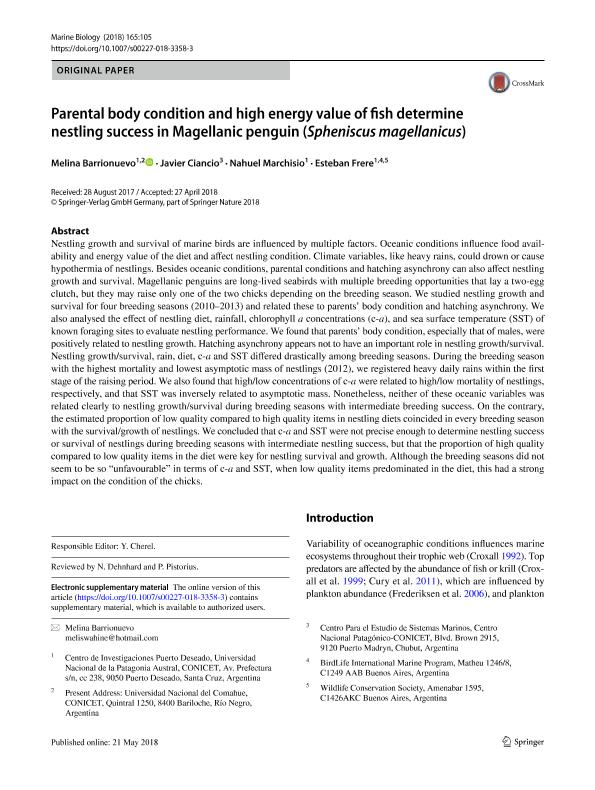Mostrar el registro sencillo del ítem
dc.contributor.author
Barrionuevo, Melina

dc.contributor.author
Ciancio Blanc, Javier Ernesto

dc.contributor.author
Marchisio, Nahuel Matías

dc.contributor.author
Frere, Esteban

dc.date.available
2020-03-18T13:50:25Z
dc.date.issued
2018-06
dc.identifier.citation
Barrionuevo, Melina; Ciancio Blanc, Javier Ernesto; Marchisio, Nahuel Matías; Frere, Esteban; Parental body condition and high energy value of fish determine nestling success in Magellanic penguin (Spheniscus magellanicus); Springer; Marine Biology; 165; 6; 6-2018
dc.identifier.issn
0025-3162
dc.identifier.uri
http://hdl.handle.net/11336/99973
dc.description.abstract
Nestling growth and survival of marine birds are influenced by multiple factors. Oceanic conditions influence food availability and energy value of the diet and affect nestling condition. Climate variables, like heavy rains, could drown or cause hypothermia of nestlings. Besides oceanic conditions, parental conditions and hatching asynchrony can also affect nestling growth and survival. Magellanic penguins are long-lived seabirds with multiple breeding opportunities that lay a two-egg clutch, but they may raise only one of the two chicks depending on the breeding season. We studied nestling growth and survival for four breeding seasons (2010–2013) and related these to parents’ body condition and hatching asynchrony. We also analysed the effect of nestling diet, rainfall, chlorophyll a concentrations (c-a), and sea surface temperature (SST) of known foraging sites to evaluate nestling performance. We found that parents’ body condition, especially that of males, were positively related to nestling growth. Hatching asynchrony appears not to have an important role in nestling growth/survival. Nestling growth/survival, rain, diet, c-a and SST differed drastically among breeding seasons. During the breeding season with the highest mortality and lowest asymptotic mass of nestlings (2012), we registered heavy daily rains within the first stage of the raising period. We also found that high/low concentrations of c-a were related to high/low mortality of nestlings, respectively, and that SST was inversely related to asymptotic mass. Nonetheless, neither of these oceanic variables was related clearly to nestling growth/survival during breeding seasons with intermediate breeding success. On the contrary, the estimated proportion of low quality compared to high quality items in nestling diets coincided in every breeding season with the survival/growth of nestlings. We concluded that c-a and SST were not precise enough to determine nestling success or survival of nestlings during breeding seasons with intermediate nestling success, but that the proportion of high quality compared to low quality items in the diet were key for nestling survival and growth. Although the breeding seasons did not seem to be so “unfavourable” in terms of c-a and SST, when low quality items predominated in the diet, this had a strong impact on the condition of the chicks.
dc.format
application/pdf
dc.language.iso
eng
dc.publisher
Springer

dc.rights
info:eu-repo/semantics/openAccess
dc.rights.uri
https://creativecommons.org/licenses/by-nc-sa/2.5/ar/
dc.subject
isotopos
dc.subject
crecimiento de pichones
dc.subject
condicion fisica de los padres
dc.subject.classification
Biología Marina, Limnología

dc.subject.classification
Ciencias Biológicas

dc.subject.classification
CIENCIAS NATURALES Y EXACTAS

dc.title
Parental body condition and high energy value of fish determine nestling success in Magellanic penguin (Spheniscus magellanicus)
dc.type
info:eu-repo/semantics/article
dc.type
info:ar-repo/semantics/artículo
dc.type
info:eu-repo/semantics/publishedVersion
dc.date.updated
2020-01-30T21:59:50Z
dc.journal.volume
165
dc.journal.number
6
dc.journal.pais
Alemania

dc.journal.ciudad
Berlin
dc.description.fil
Fil: Barrionuevo, Melina. Universidad Nacional del Comahue; Argentina. Consejo Nacional de Investigaciones Científicas y Técnicas; Argentina. Universidad Nacional de la Patagonia Austral. Unidad Académica Caleta Olivia. Centro de Investigaciones Puerto Deseado; Argentina
dc.description.fil
Fil: Ciancio Blanc, Javier Ernesto. Consejo Nacional de Investigaciones Científicas y Técnicas. Centro Científico Tecnológico Conicet - Centro Nacional Patagónico. Centro para el Estudio de Sistemas Marinos; Argentina
dc.description.fil
Fil: Marchisio, Nahuel Matías. Universidad Nacional de la Patagonia Austral. Unidad Académica Caleta Olivia. Centro de Investigaciones Puerto Deseado; Argentina. Consejo Nacional de Investigaciones Científicas y Técnicas; Argentina
dc.description.fil
Fil: Frere, Esteban. Universidad Nacional de la Patagonia Austral. Unidad Académica Caleta Olivia. Centro de Investigaciones Puerto Deseado; Argentina. Wildlife Conservation Society; Estados Unidos. BirdLife International Marine Program; Argentina. Consejo Nacional de Investigaciones Científicas y Técnicas; Argentina
dc.journal.title
Marine Biology

dc.relation.alternativeid
info:eu-repo/semantics/altIdentifier/url/http://link.springer.com/10.1007/s00227-018-3358-3
dc.relation.alternativeid
info:eu-repo/semantics/altIdentifier/doi/http://dx.doi.org/10.1007/s00227-018-3358-3
Archivos asociados
